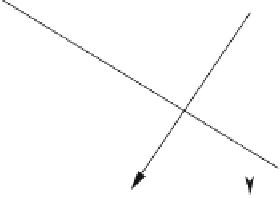Graphics Reference
In-Depth Information
So far, all this seems reasonable and consistent, but how do we interpret the following equation,
where the c term is negative?
06x
+
08y
=−
2
(3.10)
Figure 3.8 shows what its graph looks like.
1
3
-
X
-3
2
0.6
x
+
0.8
y
=
-2
n
=
-
0.6
i
-
0.8
j
2
-2
-
Y
Figure 3.8.
Obviously, the Euclidean perpendicular distance from the origin to the line cannot be negative.
Furthermore, Fig. 3.8 shows that the normal vector
08
j
, which provides the real
clue. These two facts are simply reminding us to rewrite Eq. (3.10) in a form that preserves a
positive c term, which is achieved by multiplying Eq. (3.10) by
n
ˆ
=−
06
i
−
−
1:
−
06x
−
08y
=
2
Now the vector components are correct, and the perpendicular distance from the origin to the
line is
2. Nevertheless, Eq. (3.10) is still valid algebraically, it's just that a positive c term makes
geometric sense and makes the normal vector components explicit.
+
3.4 The general form of the line equation
The general form of the line equation is
ax
+
by
+
c
=
0
The meanings of a b, and c are still the same as before, all that we have done is to form a
single expression that equals zero for any point on the line. Thus, Eq. (3.9) would be written as
06x
+
08y
−
2
=
0
This is a convenient notation that lends itself to space partitioning. But before we look at this,
consider how the following general form of the line equation is converted into its Cartesian
equivalent:
06x
+
08y
+
2
=
0









